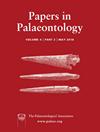The rise and fall of the Iberian cobras (Elapidae, Naja) in the context of their European and global fossil record
IF 2.2
2区 地球科学
Q1 PALEONTOLOGY
引用次数: 0
Abstract
Very few remains of elapid snakes are known from the Iberian Peninsula, but these include a probable endemic extinct species of cobra,从欧洲和全球化石记录看伊比利亚眼镜蛇(Elapidae,Naja)的兴衰
伊比利亚半岛已知的伶蛇遗骸非常少,但其中包括一种可能已灭绝的特有眼镜蛇,即晚中新世的 Naja iberica。我们在本文中描述了来自瓦莱斯-佩内德斯盆地(西班牙加泰罗尼亚)几个中新世中晚期地点的眼镜蛇脊椎骨。所有这些化石在本文中都被归类为 Naja 属的一个不确定物种。这些化石是第一个确凿的证据,证明眼镜蛇在梅西尼盐度危机之前就出现在伊比利亚,并在整个中新世(最终直到上新世)一直存在。最近,根据头盖骨和脊椎骨形态学对已灭绝的 Naja 进行了系统发育,确认伊比利亚眼镜蛇是一个独立的品系,与主要由 Naja romani 代表的中欧品系不同。然而,由于分类学上的不确定性,目前仍不清楚伊比利亚眼镜蛇是属于一个单一的品系,还是有多个 Naja 品系栖息在伊比利亚半岛。伊比利亚眼镜蛇在上新世末期灭绝。在瓦莱斯-佩内德斯盆地,眼镜蛇生活在一个马赛克环境中,经历了以不同环境特征为特征的不同阶段。
本文章由计算机程序翻译,如有差异,请以英文原文为准。
求助全文
约1分钟内获得全文
求助全文
来源期刊

Papers in Palaeontology
PALEONTOLOGY-
CiteScore
4.50
自引率
4.30%
发文量
55
期刊介绍:
Papers in Palaeontology is the successor to Special Papers in Palaeontology and a journal of the Palaeontological Association (www.palass.org). The journal is devoted to the publication of papers that document the diversity of past life and its distribution in time and space.
Papers in Palaeontology is devoted to the publication of papers that document the diversity of past life and its distribution in time and space. As a sister publication to Palaeontology its focus is on descriptive research, including the descriptions of new taxa, systematic revisions of higher taxa, detailed biostratigraphical and biogeographical documentation, and descriptions of floras and faunas from specific localities or regions. Most contributions are expected to be less than 30 pp long but longer contributions will be considered if the material merits it, including single topic parts.
The journal publishes a wide variety of papers on palaeontological topics covering:
palaeozoology,
palaeobotany,
systematic studies,
palaeoecology,
micropalaeontology,
palaeobiogeography,
functional morphology,
stratigraphy,
taxonomy,
taphonomy,
palaeoenvironmental reconstruction,
palaeoclimate analysis,
biomineralization studies.
 求助内容:
求助内容: 应助结果提醒方式:
应助结果提醒方式:


